Smith & Wesson - American legend
9mm pistols Smith & Wesson V 39/59
The world-famous Smith & Wesson company was founded a century and a half ago, in 1852, by two American gunsmiths Horace Smith and Daniel B. Wesson in Norwich (Connecticut). Since then, for most people, the name of this one of the most famous American armory firms are invariably associated with revolvers of the same name. And this is true, until the middle of the last century it was true.
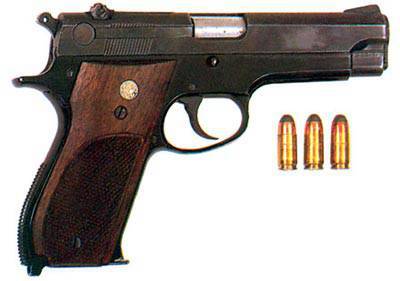
9mm pistol Smith & Wesson M 39
During World War II alone, Smith & Wesson produced more than one million Smith & Wesson .38 Military & Police model revolvers for the American and British armies. And only after 1945, this company returned to the production of civilian weapons, including self-loading pistols.
In 1948, the high command of the US armed forces tried to replace the obsolete .45 Colt M1911 A1 pistol in service with a new, more modern weapon. For this, a special competition was organized, which included comprehensive tests of the proposed samples. In 1949, specifically for this purpose, on the initiative of the executive director of Smith & Wesson, K. Hellstrom, all weapons production in Springfield was moved to new, more spacious buildings. The Smith & Wesson firm, whose management had long dreamed of receiving a large military order, had already created by this time prototypes of a self-loading pistol with a single-action trigger mechanism. This weapon was tested along with samples from other firms at the Springfield Armory, which was owned by the state at the time. However, the tests that began with great fanfare were not even brought to an end, since the Pentagon suddenly changed its mind, deciding to keep the Colt M 1911 A1 pistols as service weapons of the US Army units and subdivisions. Less than five years later, however, in 1953 they again started talking about replacing the Colt pistol. And again, like last time, Smith & Wesson had a prototype pistol with a double-action trigger, borrowed from the German "Walter" P.38, at the ready. It was developed by the lead designer of the firm Joseph Norman and became the first pistol in the United States with a self-cocking (for the first shot) firing mechanism. The new pistol, designed to use the 9x19 Parabellum pistol cartridge, made a good impression on the specialists.
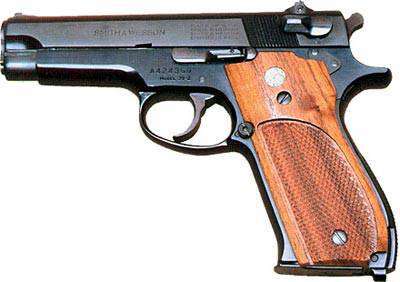
9mm pistol Smith & Wesson M 39-2
The company Colt, the main competitor of Smith & Wesson in the struggle for lucrative army orders, did not doze, and developed a Colt pistol (model Commander) especially for the army. However, like last time, the tests that had already begun were canceled again.
The Colt M 1911A1 pistol remained in service in the United States, and Smith & Wesson, in turn, tried to conquer the civilian market with its new products (in fact, it simply had nothing else to do). She proposed in 1958 pistols of two models at once - M 39, with a self-cocking trigger mechanism (double action) and its version - M 44, with a single action trigger mechanism. This is how the first generation Smith & Wesson pistols appeared.
The principle of operation of the automatic gun M 39 - the use of recoil energy in the short course of the barrel. Coupling of the barrel with the bolt was carried out by one protrusion on the upper surface of the barrel for the groove on the inner surface of the housing and bolt, locking - lowering the barrel according to the Browning scheme, with the interaction of an inclined protrusion in the lower rear part of the barrel with grooves in the frame of the gun. The sight sight had a micrometric adjustment in two planes. Shop box-shaped, single-row with a capacity of 8 cartridges. The frame of the serial 39 M pistols was made of aluminum alloy, and the valve cover was made of steel. They were covered with blue bluing. The second version of the 39 M pistol had a steel frame and bolt cover. But it was released in very limited quantities - about 900 units. The pistol M 39, intended for the civilian market, received the cheeks of the handle from the walnut tree, while in the service version of the cheek the handles were made of black plastic.
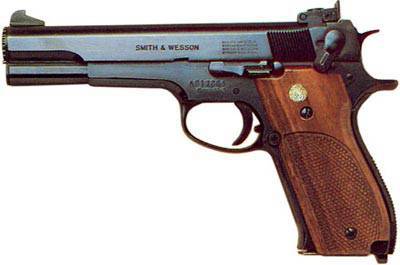
9mm pistol Smith & Wesson M 52
The new pistol from Smith & Wesson M 39 proved to be so reliable and had such a high accuracy of combat that its version, completely made of stainless steel, was purchased in 1968 for the special operations forces of the US Navy - "Navy seals". This weapon was widely used by American saboteurs during the Vietnam War. However, the firm managed to achieve a decisive breakthrough only in 1967, when the Illinois state police department adopted the M 39 pistol as a service weapon and announced the rearmament of all personnel with this model. This decision served as a kind of signal for the police leadership of other states. A chain reaction began: US law enforcement agencies almost without exception began to switch from obsolete 6-round Colt and Smith & Wesson revolvers to self-loading M 39 pistols. The dam was broken, and to Smith & Wesson Inc. a flurry of orders fell. The company produced M 39 pistols from 1954 to 1966.
In 1966, an improved version of the pistol appeared in the USA, which received the designation "M 39-1". This pistol differed from its predecessor only in the presence of a frame made of lightweight alloy. Pistols M 39-1 were produced in 1966 - 1971. In 1971, they were replaced in production by another version of the Smith & Wesson Model 39-2 pistol, which had only an improved extractor, all other structural elements remained the same as in the M 39-1 model. In addition to these models, another version of the M 39 pistol - Model 44 with a single action trigger mechanism was produced in very small quantities.
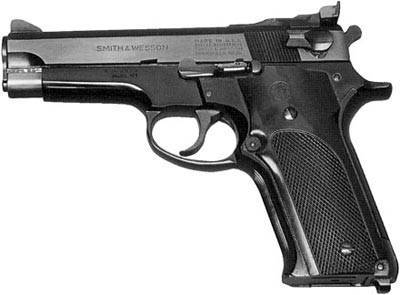
9mm pistol Smith & Wesson M 59 (sports version)
Despite the annually growing production volumes, the demand for weapons of this type did not fall, therefore, in the same 1971, Smith & Wesson presents to potential buyers its new model 59 pistol, which is often called the older brother of the M 39. He compiled with his predecessor the so-called "first generation" of Smith & Wesson pistols. The upgraded M 59 pistol was specially developed at the request of the police and other US law enforcement agencies, since the police leadership quite rightly believed that the capacity of the 39-round magazine in the model 8 pistol was completely insufficient for a regular police weapon. Therefore, the modernized pistol was a variant of the popular Model 39 pistol, but with an increased two-row magazine with a capacity of 14 rounds. It was also designed to use the 9x19 Parabellum cartridge. The rear sight in the M 59 pistol could be moved using the adjusting screw. Another difference of the new model was the pistol grip with a straightened rear part, otherwise its design was identical to the "Model 39".
The Smith & Wesson M 59 pistol had high combat and service-performance qualities and soon won general sympathy not only as a civilian short-barreled weapon, but also as a service model in US law enforcement agencies. Many United States police forces and services began to rearm with M 59 pistols. Smith & Wesson Inc. produced 9-mm pistols M 59 from 1971 to July 1982 inclusive.
Second generation Smith & Wesson pistols
9mm pistols Smith & Wesson V 439/469
In 1978, the US Department of Defense announced the third competition to create a new model of a service pistol to replace the outdated Colt M 1911 A1 pistol in .45 caliber and the Smith & Wesson M 15 revolver in .38 caliber, which had been in service with various army units and divisions for several decades. , and invited the largest arms manufacturers to take part in the tests. At the same time, a number of requirements were put forward, which, in the opinion of the military, the new weapon had to meet. The prospect of getting almost the largest ever history the existence of the company, a military order prompted Smith & Wesson to substantially revise the design of its pistols. As you know, the Italian pistol "Beretta" 92F won the army trials, but Smith & Wesson could not allow the significant funds spent on the development of a competitive model to go to waste, so it had to focus its efforts on the civilian market.
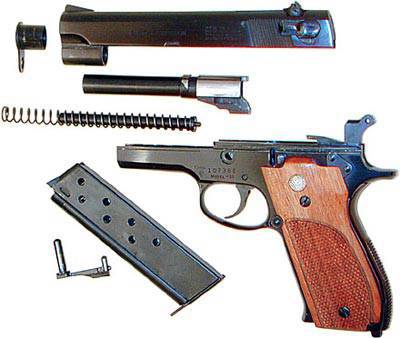
Partial disassembly of the pistol Smith & Wesson M 39
In 1981, Smith & Wesson discontinued the Model 39 and 59 pistols and their variants. They were replaced by new models 439, 539, 459 and 559. Now, in Smith & Wesson pistols, the first number meant the frame material, the next two - the old model numbers. The first examples in accordance with this system were models 39 and 59. The number "4" stood for the frame made of light aluminum alloy, "5" for the carbon steel. The second and third digits indicated the caliber, frame size and magazine capacity: so "59" is a 9 mm pistol with a double-row magazine with a capacity of 14 rounds; "39" - 9 mm caliber with single-row magazines with a capacity of 8 rounds.
Pistols of the second generation differed from their predecessors in different materials used for the manufacture of the frame and casing-bolt; more advanced sights; rejection of the use of a separate muzzle gate clutch; and some other features, however, they basically remained structurally identical to the 39 and 59 models. The bevel of the chamber in these pistols was made longer and flatter, which ensured a steady supply of X-NUMX-mm Parabellum cartridges from the magazine to the chamber with any type of bullets, which was important for military weapons.
For the first series M 439 pistols, the trigger guard had a rounded shape, but since 1984, this weapon has been produced only with a rectangular safety bracket.
The M 459 pistol was covered with blue bluing, the grip cheeks were made of nylon-based plastic. Variants with constant and variable sighting devices were on sale. In addition, the buyer could choose an option with a one-sided or two-sided safety catch on the casing-shutter. Until 1984, this pistol also had a rounded trigger guard, which later acquired a rectangular shape. The dimensions of the M 459 pistol are the same as those of the M 59, however, despite the presence of a lightweight alloy frame, the new version turned out to be even somewhat heavier than its predecessor. Smith & Wesson also produced the M 459 with a nickel plated finish, but the number of these pistols was insignificant.
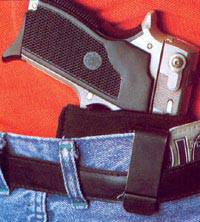 Concealed carrying of a Smith & Wesson M 469 pistol in an "operational" holster behind a belt
Concealed carrying of a Smith & Wesson M 469 pistol in an "operational" holster behind a beltPistol M 559, made entirely of carbon steel, was available in two versions: with a constant and variable sighting device. A total of 3750 pistols of this model were manufactured.
In 1983, the American gunsmiths mastered the production of another 9 mm M 469 "Mini Gun" pistol with a self-retracting trigger mechanism, which represented a shortened version of the 459 M for concealed carrying as a second (spare) pistol. It was designed in accordance with the requirements of the US Air Force and had a shortened frame, barrel and handle, with a two-row magazine with a capacity of 12 cartridges. The 469 M pistol had the same curved, as the 459 M, rear end of the handle and a safety bracket adapted for shooting with two hands. In this model, the trigger was missing a needle, which during arming could interfere, and its upper surface was made corrugated to facilitate the platoon.
Since 1982, the company has begun to develop a new series of pistols, for the production of which only special grades of stainless steels were used (this was required by the current market situation in the arms market). The two new pistols were assigned model numbers 639 and 659. However, the first second generation Smith & Wesson stainless steel pistol did not hit the civilian market until 1984.
At the same time, the 639 model M entered the market in two versions with a one-way or two-way flag-breaker mounted on the cover-casing. At the first samples of these pistols, the trigger guard had a rounded shape, but since 1985, it has become rectangular.
A version of the 559 model M, made entirely of stainless steel, under the designation M 659 was completed with a variable or fixed sighting device, while there were also versions of it with a one-sided or two-sided safety lever.
In 1986, a new Smith & Wesson M 669 pistol appeared on the American arms market, which was a twelve-shot compact version of the M 659 pistol with a double-action trigger mechanism and an 89 mm barrel. The frame of the pistol was made of aluminum alloy, and the casing was made of stainless steel. The open mechanical sight was adjustable only in the horizontal plane. The grip cheeks received a new design - instead of two separate cheeks (left and right), made of plastic or wood, a single piece was now mounted - the pistol grip, which consisted of the left and right cheeks, connected by a back wall. The grip cheeks were now made of a new type of plastic "delrin" (polymethylene oxide) from Du Pont, which, along with their narrower shape, significantly improved the grip of the weapon.
From the very beginning, Smith & Wesson specialized mainly in the production of pistols exclusively chambered for 9x19 "Parabellum" cartridges. This situation changed only in 1984, when the prevailing market conditions prompted Smith & Wesson to release a pistol made entirely of stainless steel and designed to use the most common pistol cartridge in America - the .45 automatic transmission.
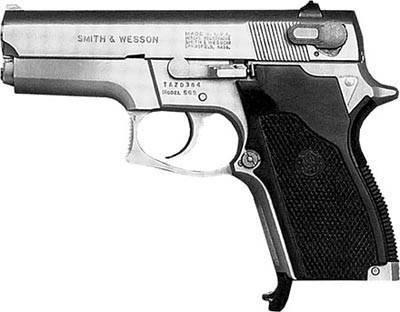
9mm pistol Smith & Wesson M 669
The new pistol was an enlarged modification of the Parabellum 9 caliber pistol. The total length of this model with an enlarged frame is almost the same as that of its main rival - the Colt pistol M 1911 A1 Government, but the handle is slightly wider and the self-firing double-action firing mechanism. In addition, this eight-charge pistol, designated M 645, did not have a separate barrel sleeve, instead it had a tide from the muzzle, the outlines of which were fitted to the internal profile of the casing-bolt. The safety clip of the gun was made rectangular and provided with a notch on the front surface. Mushka had a red plastic insert.
The safety catch was copied from 439 / 559 M models of the 9 caliber Parabellum. When it was turned on, the trigger of the gun went down and did not touch the drummer. At the request of the buyer, the model could be equipped with a safety lever with both its one-sided and two-sided arrangement. The design of the gun and the presence of an automatic fuse, which ceased to block the drummer, only when the trigger was squeezed to the end. This meant that even with a fully cocked trigger a shot can be made only by pressing the trigger. In the event of an accidental breakdown of the trigger (for example, as a result of wear of the working surfaces of the sear, sliding of a finger during a careless cocking or falling of the weapon), a shot will not occur. Pistols of this type were also supplied with a magazine fuse that blocked the trigger when the magazine was removed. The store itself had numbered holes on the case, through which the shooter can see how many cartridges are left in the store. There were a significant number of variants of the 645 model, many of which remained in production for only a few years.
Third generation Smith & Wesson pistols
In 1988, Smith & Wesson began implementation of its project to improve self-loading pistols, designated "AIP". As a result of these works, in which both professional designers and many users of Smith & Wesson pistols, including military personnel, police officers and athletes, participated, in 1990, the so-called third generation pistols appeared. They differed from their predecessors, along with an improved trigger mechanism with new calibers, a more modern exterior design, which, however, was more cosmetic than constructive.
The third-generation pistols have again changed the numbering system of models (instead of three figures - four). The first two digits now denoted the basic model or the corresponding caliber: "39" (9-mm with single-row magazines on 8 cartridges); "59" (9-mm with two-row magazines on 15 cartridges); and "69" (9-mm compact, with two-row magazines on 12 cartridges); and pointed to pistols chambered for 9x19, "10" - for pistols chambered for 10 mm Auto, "40" - on .40 SW and "45" - on .45 AKP. The third digit indicated the type of firing mechanism and frame size: “O” (with double-action firing mechanism with safety catch / trigger release lever); "1" (with double action trigger with safety catch / trigger lever, compact); "2" (with a double-action trigger mechanism, only with the safety trigger lever on the frame); "3" (with a double-action trigger mechanism, only with the safety trigger lever on the frame); "4" (with a double action trigger only); "5" (with a double-action trigger only, compact); "6" (with a double action trigger with safety catch / trigger lever); "7" (with a double-acting trigger mechanism, only with a lever for safe descent of the trigger on the frame, compact); "8" (with a double action trigger only). The fourth digit designated the frame material (covers-gates on all models - from stainless steel): "3" - a light anodized frame from a light aluminum alloy; "4" - blued frame made of lightweight aluminum alloy; "5" - carbon steel frame; "6" - stainless steel frame.
9-mm pistol Smith & Wesson M 3914 LS (Ledysmith)
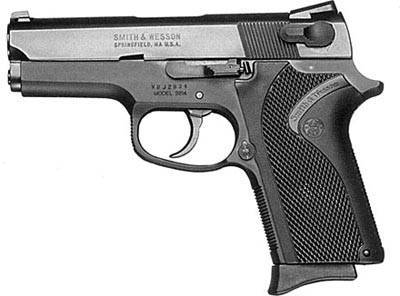
Smith & Wesson pistols of the new series were created on the basis of existing models designed for the 9 mm "Parabellum" cartridge. At the same time, new samples appeared, developed for the .40 SW cartridge on the basis of 9 mm caliber pistols, and the 10 mm Auto caliber based on .45 caliber pistols (with an enlarged frame).
In 1988, Smith & Wesson Inc. introduced its latest third generation pistols, 3900 and 5900 series.
At present, the family of third generation Smith & Wesson pistols includes over 70 models designed for the use of seven cartridges (9x19 "Parabellum", 9x21, .356 SW, 10 mm Auto, .40 SW, .45 ACP). These pistols are available in seven basic versions: standard (service); military; compact; ultra-compact; "thin" (ultra-compact with a single-row magazine for hidden carrying), and all of the above modifications have their additional options with the TSW index (Tactical Smith Wesson - tactical Smith-Wesson), which differ from the basic models by the presence of a guide bar under the barrel for mounting a laser designator or combat lantern; as well as practical (long-barreled for sports and combat shooting) and sports. In addition, the third generation pistols include several more "cheap" (value series) models of pistols created on the basis of the more expensive Smith & Wesson pistols M 4003, M 3903, M 5903 and M 4573. New samples are intended only for the civilian market, so they received three-digit model index.
As a military (service) weapon in the US army and law enforcement agencies, standard, military and compact Smith & Wesson pistols are mainly used. Ultra-compact (ultra-small) and "thin" pistols are mainly used in the police as a backup weapon or for self-defense off-duty, as well as civilian self-defense weapons.
The Smith & Wesson Model 3906 pistol appeared in 1988. It was designed for the 9x19 "Parabellum" cartridge and had a shutter casing and a stainless steel frame. Overall length - 194 mm; barrel length - 102 mm; weight - 0,85 kg. Since 1999, the M 3906 pistol has been equipped with a low-profile sighting device with three luminous points for shooting in low light conditions "Novak LoMount".
The compact-series pistol Model 3913 appeared in the 1988 year. This compact eight-shot gun is a shortened version of the 5900 model. It is designed for use of the 9x19 “Parabellum” cartridge with a barrel length of 89 mm, a self-propelled trigger mechanism, a frame made of lightweight aluminum alloy and a stainless steel shutter casing. In 1989, the pistol received a new designation M 3913 TSW. Models of this series are equipped with sighting device with tritium inserts and trigger without a shank. In addition, under the frame of the gun in front of the safety bracket mounted guide bar for LCC or combat flashlight. Pistol M 3913 is in production from 1989 year to the present.
In 1990, a new elegant model of this pistol was released, which was given the old legendary Smith-Wesson name M 3913 LS (Ledysmith). The frame of the Ladysmith pistol is made of a lightweight alloy, and the shutter casing is made of stainless steel. Flap fuse mounted on the left side of the housing-bolt. Pistol M 3913 LS is designed for cartridges 9x19 "Parabellum" and has a magazine capacity 8 cartridges. The only difference between the 3913 LS models and the standard 3913 M pistol models was the modified angle of the pistol grip, which made them more comfortable to wear in a holster, and the frame and front end of the casing-bolt, which gave the new models a certain individuality, received a slightly different shape. The inscription "Ledysmith" is applied to the frame with a laser.
Another version of the Model 3913 pistol with a blue burnishing coating also appeared in early 1990 under the designation "Smith & Wesson M 3914". The frame of the pistol is made of a lightweight alloy, and the casing is made of carbon steel. On the frame of this model there is no inscription "Ledysmith", in addition, all the outer edges of the weapon are noticeably rounded. At the end of the same, 1990, Smith & Wesson released another version of this pistol - Model 3914 LS (Ledysmith). Both pistols are equipped with Novak LoMount sights, which are installed on a number of third generation Smith & Wesson pistols.
In 1991, Smith & Wesson released another version of the M 3914 pistol, designated "Model 3954". It, along with a double-acting only trigger mechanism (DAO) and a blue burnishing coating, had a frame made of lightweight aluminum alloy and a casing made of carbon steel.
The Smith & Wesson Model 5903 pistol, which appeared in 1988, was the second basic model of the third generation weapon, created on the basis of the modernized version of the M 59 and designed to use the 9x19 Parabellum pistol cartridge.
This model had a stainless steel frame of a lightweight aluminum alloy and a stainless steel shutter casing. The gun was released with a constant or variable sighting device. From 1993, the weapons began to be completed with the Novak LoMount sight, grasping the cheeks of a pistol grip from a brand of hard rubber from Du Pont and a double-sided safety catch located on the cover-cage. M 5903 was produced for 10 years, from 1988 to 1998 year inclusive.
In 1990, Smith & Wesson mastered in production its special compact version M 5903 SSW. This pistol had a barrel length of 89 mm, a Novak LoMount sight and gripping cheeks from a Du Pont Delrin pistol grip. The frame is made of lightweight aluminum alloy, which has been given the appearance of stainless steel, and the casing is made of stainless steel and is blue burnished. In 1990, only 1500 pistols of this modification were manufactured.
In the same 1990, the company released another version of the M 5903 - the Smith & Wesson M 5924 pistol with a frame made of lightweight alloy, a steel shutter casing coated with blue bluing. This pistol also had a Novak LoMount scope. However, the M 5924 was in serial production for only a few months, and soon its production was discontinued.
In 1991 the next improved model of this pistol "M 5943" (1991 model) was mastered in production. The M 5943 pistol had a frame made of lightweight aluminum alloy, a stainless steel shutter-cover, a double-acting trigger mechanism, and a Novak LoMount sight. In the same year, Smith & Wesson released a special compact modification of this weapon, designated "M 5943 SSW".
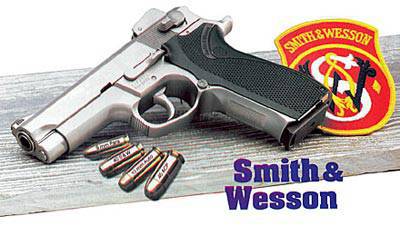
9mm pistol Smith & Wesson M 5906
In 2000, a modern modernized version of the M 5943 model appeared - the Smith & Wesson Model 5943 TSW pistol (2000 model). This fifteen-shooter with a double-action trigger was equipped with a lightweight aluminum alloy frame and a stainless steel bolt cover. As standard, the pistol had a Novak LoMount Novak sight with tritium inserts and a trigger without a shank. Under the frame in front of the safety bracket, a guide bar is mounted for attaching a laser control center or a combat flashlight. The only difference between this weapon and other models of pistols in the 5900 series is its weight, which was 0,81 kg.
The pistol Smith & Wesson Model 5904, chambered for 9x19 "Parabellum", also appeared in 1988. The M 5904 pistol was produced with a blued frame made of lightweight aluminum alloy and a carbon steel shutter-casing, which could be coated with either blue bluing or nickel plating. The first samples of the M 5904 were produced with both constant and variable sights, but since 1993 the Novak LoMount scope has become the standard. The capacity of the double-row magazine of the M 5904 pistol has increased to 15 rounds.
Smith & Wesson also produced in limited quantities a modification of this pistol for the pistol cartridge 9x21, intended exclusively for sale on the Italian arms market. In 1989-1991, Smith & Wesson produced another version of this pistol in very limited quantities, designated "M 5905". It had a frame and a shutter casing made of carbon steel. The pistol was covered with blue bluing and was equipped with a Novak LoMount sight.
In addition, from 1991 to 1992, Smith & Wesson produced another pistol "M 5944", which was a modification of the M 5904 with a double-acting trigger mechanism only. The pistol had a lightweight aluminum frame, a stainless steel shutter cover and a Novak LoMount sight.
The pistol Smith & Wesson Model 5906, chambered for 9x19 "Parabellum", was put into mass production in 1989. His frame and casing were made of stainless steel. The pistol was produced with both a constant and variable sighting device. Since 1993, M 5906 pistols have received the Novak LoMount sight. This model was also produced for the Italian market chambered for 9x21.
 Signature Smith & Wesson logo
Signature Smith & Wesson logoIn 1990, Smith & Wesson started production of a new modification of this pistol "Model 5926". It was also entirely made of stainless steel, but on the left side of the bolt-casing, instead of a safety flag, it had a safety trigger lever mounted. Model M 5926 was equipped with Du Pont hard rubber pistol grip cheeks and Novak LoMount sight. The Smith & Wesson M 5926 pistol was produced from 1990 to 1993 inclusive.
The following year, 1991, Smith & Wesson began production of the Model 5946 pistol, which is an improved version of the M 5906 pistol. The model differed from its prototype only by a double-action trigger mechanism. The pistol was equipped with a stainless steel frame and shutter-casing, a Novak LoMount sight, as well as Du Pont rubber grip grip cheeks. Currently, the Smith & Wesson M 5906 pistol is still in production.
The total length and length of the barrel are the same as those of the other modifications of the 59 M, and the weight is 1,06 kg.
In 2000, the Smith & Wesson "Model 5946 TSW" pistol was presented to potential buyers. This weapon had a double-acting only trigger mechanism (DAO), a Novak LoMount sight with tritium inserts for night shooting. There is no trigger shank; under the frame there is a guide bar for special devices such as LTsU or a combat flashlight. The mass of the M 5946 TSW pistol is 1,09 kg.
In the same year, another version of this weapon was born - a typically army pistol Smith & Wesson M 5906 M (Military). Its frame and shutter-casing, although made of stainless steel, have a matte black color thanks to the polymer melonite coating. A double-sided trigger safe trigger is mounted on the bolt casing. The weapon is equipped with a Novak LoMount sight with three luminous points-inserts and grip cheeks made of hard rubber from Du Pont, with a ring for attaching a safety cord. The capacity of the double-row magazine is 15 rounds.
Total length - 191 mm, barrel length - 102 mm, weight (without cartridges) - 1,06 kg.
In 2000, Smith & Wesson introduced another model of this pistol in the M 5906 TSW variant with a Novak LoMount sight with tritium inserts. Under the frame there was a guide bar for attaching an LCU or a combat flashlight. The magazine capacity of the new pistol with a double-action trigger was also 15 rounds. Its dimensions are identical to those of other 5906 models, but its weight is slightly higher: M 5906 TSW weighs 1,09 kg.
TACTICAL-TECHNICAL CHARACTERISTICS OF GUNS Smith & wesson
Name Caliber, mm Total weight, kg Overall length, mm Barrel length, mm Magazine capacity, cartridges
M 39 9x19 0,78 192 102 8
M 59 9x19 0,84 192 102 14
M 459 9x19 1,02 192 102 14
M 469 9x19 0,73 175 89 12
M 559 9x19 0,85 192 102 14
M 645 .45ACP - 225 127 7
M 659 9x19 0,85 192 102 14
M 669 9x19 0,74 175 89 12
M 3913 9x19 0,7 171 89 8
M 3953 9x19 0,7 171 89 8
M 5903 9x19 0,8 190 102 15
M 5906 9x19 1,07 190 102 15
M 5943 9x19 0,8 190 102 15
M 5946 9x19 1,07 190 102 15
Information